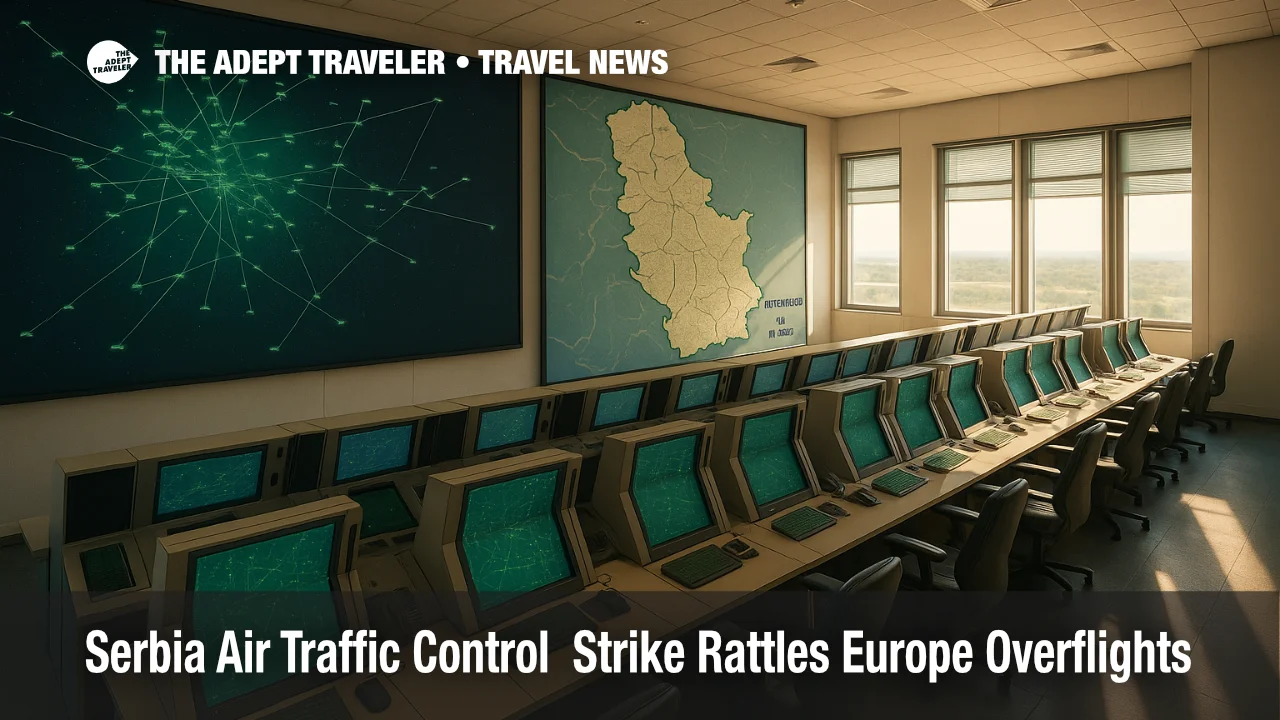Serbia Air Traffic Control strike rattles Europe overflights

Serbia and Montenegro Air Traffic Services, known as SMATSA, has confirmed an air-traffic-control strike running from August 19 through September 30. Minimum service is in place, but Europe-bound flows that cross Serbian airspace are already feeling delays and tactical reroutes. Ryanair reported 99 delayed flights and 17,800 disrupted passengers during August 20 to 21, underscoring the immediate network impact beyond flights to and from Belgrade. Operators are adjusting routings and spacing to keep traffic moving while the dispute continues.
Key Points
- Why it matters: Prolonged Serbia ATC strike can ripple into Europe-wide delays and missed connections.
- Travel impact: Expect miles-in-trail, reroutes, and longer block times on Balkan and East Med flows.
- What's next: The strike window runs through September 30 unless a settlement is reached.
- Official timeline: SMATSA confirms action began August 19 at 11 p.m. local and ends September 30 at 11 p.m.
- Airline response: Ryanair cites 99 delayed flights in the first two days, urging EU overflight protections.
Snapshot
SMATSA says the Air Traffic Control Union launched industrial action at 11 p.m. local on August 19, with plans to continue until 11 p.m. on September 30. Minimum service rules apply, so most flights will operate, but en-route spacing, level capping, and diversions through neighboring FIRs can extend flight times. Overflight traffic between Central Europe and Greece, Türkiye, Cyprus, and points east frequently crosses Serbian airspace, so delays may show up far from Belgrade. Ryanair has highlighted the lack of legal overflight protection in Serbia, arguing that many affected travelers are simply transiting the airspace. Travelers with tight connections to islands or secondary airports should build larger buffers and monitor airline apps.
Background
SMATSA provides en-route and terminal control for Serbia and Montenegro, a key corridor linking Central Europe with the Balkans and Eastern Mediterranean. The union's stated demands include wage increases and revisions to minimum-service arrangements. In public statements, SMATSA criticized the action as harmful to airlines and passengers, while emphasizing that safety and a minimum work process are being maintained. Regional reporting also notes the union is not registered in Montenegro, which limits the action's scope there. While the situation is fluid, the operational pattern so far mirrors past Europe ATC disputes, where capacity reductions translate into tactical reroutes and throughput constraints more than wholesale shutdowns. For earlier context, see our prior explainer, Serbia ATC strike through Sept 30 may slow overflights.
Latest Developments
Where the Serbia ATC strike hits hardest
Flows between Germany, Austria, or Italy and destinations in Greece, Türkiye, and Cyprus often file through Belgrade ACC. During the strike, airlines and the Eurocontrol network will use miles-in-trail, level capping, and neighbor-FIR routings to balance loads, adding minutes to many itineraries. These delays can cascade into missed connection banks, late-evening curfews, and next-day crew legality issues across Europe. Ryanair, which relies on dense overflight corridors, says most disrupted passengers are not traveling to or from Serbia, but simply overflying. Minimum service should keep the majority of flights operating, however schedule buffers remain thin during late-summer peaks, when convective weather is also common.
What travelers should do now
Pad connections, especially when connecting to islands or secondary airports with limited frequencies. Use your airline's app to self-rebook the moment delay codes appear. If your itinerary departs an EU or UK airport, EU261 or UK261 requires care and timely re-routing or refund during disruptions, even when cash compensation is not owed for ATC strikes. Keep receipts for meals and hotels, ask agents to endorse tickets to partners when inventory is tight, and avoid separate-ticket itineraries through September 30. Watch for carrier-issued travel waivers that relax change fees and fare differences during the strike window.
Analysis
A weeks-long Serbia ATC strike arrives at the worst possible moment, with summer traffic already stretching Europe's network. Belgrade's upper airspace sits on efficient east-west corridors, so even modest throughput cuts can ripple widely. The network typically responds with miles-in-trail, altitude capping, and tactical reroutes through adjacent FIRs. That keeps aircraft flying, but the cost is longer tracks, higher fuel burn, and eroded schedule buffers. When buffers collapse near evening curfews, small delays become cancellations or next-day resets, pushing disruptions into morning banks. Airlines will try to absorb this with padded block times and discretionary routing, yet the cumulative effect for travelers is twenty to sixty minute delays that occasionally snowball.
For planning, travelers should assume friction on itineraries that cross the Balkans or serve the Aegean, Türkiye, and Cyprus. Build longer connections, especially when moving to ferries or last flights of the day. EU261 and UK261 still mandate care and re-routing or refund, even if cash compensation is typically excluded for ATC strikes. Carriers may publish day-specific waivers, so checking your booking daily is smart, particularly ahead of weekends. Finally, keep an eye on the labor timeline. SMATSA's confirmation of an August 19 through September 30 window provides a hard boundary. If mediation narrows the dispute, constraints can ease quickly, but until then, expect rolling, network-wide knock-ons.
Final Thoughts
Most flights that overfly Serbia will still operate, but travelers should plan for minor delays and occasional misconnects while the labor action continues. Add buffer time, track your reservation closely, and know your re-routing rights. If you are traveling to island destinations, protect onward legs with earlier feeders. With minimum service in effect, the network will cope, but schedule margins remain thin until the dispute is resolved, or the window closes on September 30. Expect intermittent friction across east-west corridors and plan accordingly through the end of the Serbia ATC strike.
Sources
- SAOPŠTENjE ZA JAVNOST confirming strike window, SMATSA
- SINDIKAT KONTROLE LETENjA STUPIO U ŠTRAJK, Ministry of Construction, Transport and Infrastructure
- Air traffic controllers in Serbia go on strike, SeeNews
- Air Traffic Control Union goes on strike, minimum work process secured, eKapija
- Ryanair calls for overflight protections, first two days disrupt 99 flights, Ryanair
- Air traffic control union goes on strike, Vijesti
